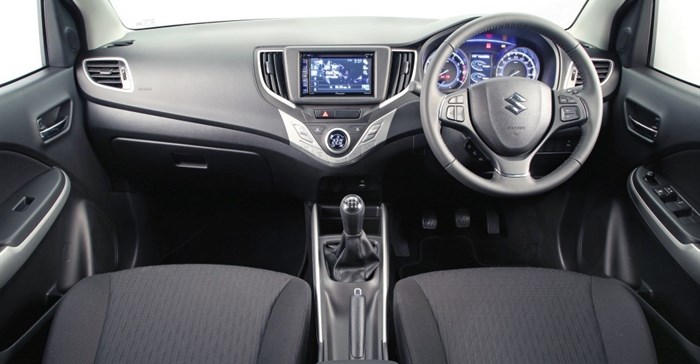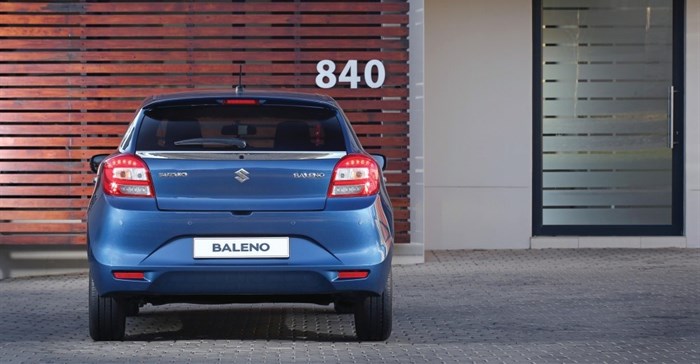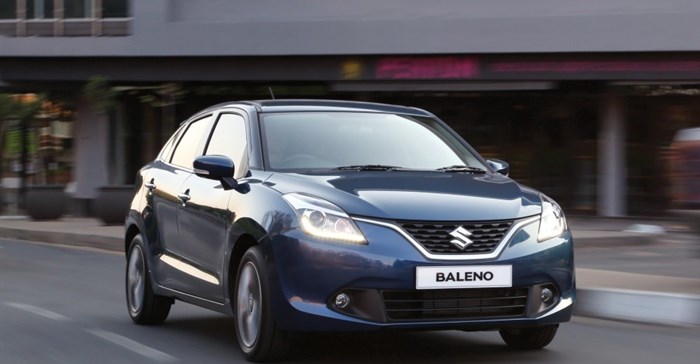The new Suzuki Baleno, which officially joined the carmaker's range of compact cars at the 2015 Frankfurt Motor Show, goes on sale in South Africa this November.
Produced in India for international markets, including Japan, the Baleno has posted sales of more than 100,000 units in just 12 months in India alone, with 60,000 back orders and a 33-week waiting period. It is currently exported to more than 30 markets around the world, including Europe and Australia.
Design theme
Suzuki used a so-called ‘Liquid Flow’ design theme for the new Baleno. The concept allows for flowing lines from front to rear, while sculpted accent lines along the sides serve to underline the streamlined shape. Blacked out A and B-pillars, a smooth roofline and a tailgate neatly integrated into the wind-cheating profile add to the look.
The front view is dominated by the deep, wide grille and large Suzuki-logo. The grille links to the bold, clear-lensed headlight clusters on either side. The integrated bumper separates the grille from the large lower air intake, with recessed fog lamps located on either side in the case of GLX models. Pronounced contours emphasise the wheel arches, which are home to 15-inch steel or 16-inch alloy wheels, depending on model.
The rear is chunky and muscular, with a broad integrated rear bumper, prominent tail light clusters and a wide-opening tailgate. A rooftop spoiler is standard on GLX models. According to the company the streamlined shape is also aerodynamically efficient with a drag coefficient of 0,299, making it the most aerodynamic production model Suzuki has ever produced.
Roomy interior
The cabin is roomier than the compact exterior proportions suggest, says Suzuki. The distance between the front seat backrest and the rear bench seat, also referred to as the tandem distance, is an impressive 805 mm, which is 70 mm more than the Swift. In overall terms, the Baleno’s interior is 87 mm longer than that of the Swift, which accounts for the singular impression of roominess in the newcomer’s cabin.
The rear bench seat is divided 60:40, allowing each section to be folded flat individually to create range of seating versus cargo space options. The luggage compartment is 355 litres with the rear bench seat raised, and can be extended to 756 litres with the rear seated folded flat. Total rear volume to roof height with the seat folded flat is 1,085 litres.
The width of the cabin is emphasised by the smooth expanse of the instrument panel, which is home to an instrument binnacle directly ahead of the driving position. A 6,2-inch colour display for the infotainment system is located in the centre stack in the case of GLX models. Ample storage is provided via the glove compartment, as well a storage binnacles in the centre console and the bottom of the centre stack. The front doors get storage pockets too, while cup holders and bottle holders are provided front and rear.
Chassis and suspension
The Baleno employs an all-new platform, designed specifically to be more rigid while reducing overall weight. Despite being larger than the Swift, the Baleno is 11 percent lighter, with a kerb mass of just 915 kg.
The Baleno’s body is an integral part of the quest for less weight and improved rigidity. Its smooth, curved shape requires fewer joints and therefore less reinforcements. Using special, high-tensile steel, the basic body shell weighs just 196 kg – the lightest in the B-segment hatchback class. Weight saving measures have been applied to every component of the new Baleno, including the doors, suspension, seats and the brakes. The reduced kerb mass benefits performance by improving the Baleno’s power-to-weight ratio, and also enhances economy.
The body also expresses Suzuki’s Total Effective Control Technology (TECT) concept, which focuses on enhancing occupant protection. Thus, the Baleno’s lightweight body and high-tensile steel panels disperse impact forces more evenly and efficiently in the case of a collision. The steering is electrically assisted, while the ABS-assisted brake system comprises front discs and rear drums in the case of the GL model, and discs all round for GLX variants.
Safety and security
All Baleno models come with ABS anti-lock brakes, augmented electronic brake force distribution (EBD) and emergency braking assistance (EBA). Dual front airbags are standard too, while GLX models also get side and curtain airbags.
Inertia reel seatbelts are fitted to all five seating positions. The front seat belts feature pre-tensioners and load limiters. Adjustable head restraints are provided for all five occupants. Other safety and security-related features include IsoFix child seat tethers integrated into the rear bench seat, childproof rear door locks, side impact protection beams and an alarm/immobiliser system. Remote central locking is also standard.
Engine and transmission
In South Africa, all three Suzuki Baleno models are powered by the same 1,4-litre engine. The K14B four-cylinder unit produces 68 kW of maximum power at 6,000 r/min, combined with a torque peak of 130 Nm at 4 200 r/min. Highlights of the normally aspirated, 1 373 cc power unit includes four valves per cylinder, variable valve timing and multipoint fuel injection.
The engine also links up to the Baleno’s weight-saving theme, thanks to an aluminium cylinder head, while a pent-roof combustion chamber, and a crossflow intake and exhaust valve configuration contribute to the engine’s efficiency.
While the same engine is used across the range, Baleno buyers have a choice of two gearboxes: a five-speed manual, and a four-speed automatic transmission. Drive is to the front wheels in both cases.
Performance and economy
With a power-to-weight ratio of 76,5 kW/ton for the manual transmission model, and 74,9 kW/ton for the automatic version, the new Baleno offers sprightly performance and impressive fuel economy. Manual gearbox derivatives accelerate from 0-100 km/h in 10,9 seconds, and achieve a top speed of 180 km/h. The automatic model boasts a 0-100 km/h sprint time of 11,6 seconds, while top speed is 170 km/h.
Suzuki says the Baleno’s light kerb mass translates into agile handling characteristics and responsive rack-and-pinion steering is electrically assisted. Average fuel consumption for the combined cycle comes to 5,1 litres/100 km for the manual model, and 5,4 litres/100 km for the automatic version. The rated CO2 exhaust gas emissions are 120 g/km for manual models, and 128 g/km for the automatic version.
Model range and specification
The new Suzuki Baleno is offered in two specification grades. The more affordable GL spec level is offered in conjunction with the manual gearbox only, while the upmarket GLX versions can be ordered with either the manual or the automatic transmissions.
Baleno GL: Standard exterior features include colour-coded exterior mirrors and door handles, blacked out A and B-pillars, multi-reflector halogen headlights, and green-tinted windows. The Baleno GL runs on 15-inch steel wheels with full wheel covers, shod with 175/65 R15 tyres. Inside the cabin, you'll find smart cloth upholstery and black dashboard trim with silver accents. The driver’s seat is height-adjustable, while the rear bench seat is split 60:40 and can be folded flat individually or completely.
Electric windows front and rear are standard, as is manual air-conditioning with a pollen filter, remote central locking, and electrically adjustable exterior mirrors. The front sun visors both feature vanity mirrors. The instrument binnacle is home to large circular dials for the speedometer and rev counter, together with indicators for engine temperature and fuel tank level. The two main dials are separated by a bright digital display for the Baleno’s on-board computer.
Selectable information includes range, instant and average fuel consumption, time, and trip distance travelled. The display also incorporates the car’s odometer.
The instruments are framed by the tilt-adjustable multifunction steering wheel, which features integrated controls for the audio system, and the Bluetooth-based hands-free telephony system.
In the Baleno GL, the audio system comprises an MP3-compatible CD receiver with six loudspeakers, offering integrated Bluetooth for both hands-free telephony and audio streaming. There’s also a USB port, a 3,5 mm stereo auxiliary input, and a 12V power socket.
Baleno GLX: The GLX specification grade offers everything on the GL list, but with some additions and upgrades. Viewed front on, the headlights represent the most noticeable difference. They feature HID projector elements and LED daytime running lights, while low-mounted recessed fog lamps are standard, too. The exterior mirror housings incorporate integrate turn indicator repeaters.
Additional exterior features that set the GLX apart from its GL stablemate include the chrome-finished door handles, as well the chrome beltline mouldings and chrome tailgate garnish, while the tailgate features a roof-end spoiler. Privacy glass for the rear windows and rear screen is standard, as are revised tail light clusters. The GLX models are fitted with upgraded wheels and tyres. The 16-inch alloys are shod with 185/55 R16 tyres.
Inside, the Baleno GLX includes a 6,2-inch TFT colour screen in the centre of the dashboard, which serves as the interface for the Baleno’s infotainment system.
The instrument cluster remains the same, but the digital display is upgraded to a 4,2-inch TFT colour display, and gains the ability to display average speed and ambient temperature, as well as a graphic representation of engine power and torque output. The steering wheel features a leather-trimmed rim, and is adjustable for both reach and rake.
The multifunction steering wheel gets additional controls for the cruise control, which is included in the GLX specification. Also upgraded is the air-conditioning, which is now fully automatic. And rear park distance control is fitted as standard, too. Remote central locking remains standard, but is augmented by keyless starting. The interior lighting adds a front map reading light to the centrally mounted cabin light, while the centre console is fitted with an armrest over the centre storage box.
GLX models gain side and curtain airbags, bringing the total tally to six, while the ABS braking system features rear disc brakes, instead of the GL model’s rear drums.
The new Baleno is covered by a standard three-year/100,000 km warranty, as well as a four-year/60 000 km service plan. Services are at 15,000 km/12 month intervals.




































